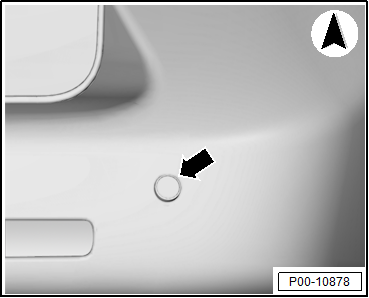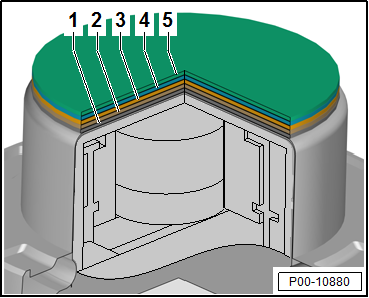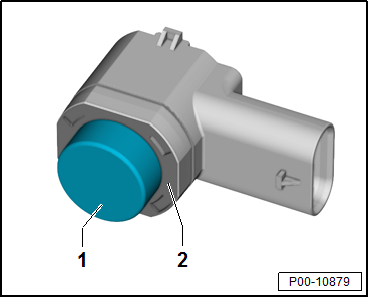Volkswagen Polo Service & Repair Manual: Parking Aid Sensor, Painting
| The following parameters must be met when painting to avoid
malfunctions in the parking aid sensor (parking aid system): |
| Maximum coat thickness 125 ┬Ąm; the coat thickness must
always be measured after painting |
| Maximum curing temperature: 1 hour at 90 ┬░C (194 ┬░F) |
| Only remove paint (sand) down to the primer |
| The minimum coat thickness of 5 - 10 ┬Ąm coating must be
maintained |
| Maximum coat thickness 125 ┬Ąm; the coat thickness must
always be measured after painting |
| Maximum curing temperature: 1 hour at 90 ┬░C (194 ┬░F) |
| Paint or paint spray must not go into the connector; the pin
contact must be guaranteed after painting |
| Dipping in cleaning solution without taping off the
connector pin beforehand is prohibited. |
| Connect the Vehicle Diagnostic Tester and check the
function. Refer to
→ Electrical Equipment General Information; Rep. Gr.97. |
|
|

|
| Paint Structure and Coat Thickness, Repairing |
| 1 - |
Primed New Part with Replacement Part Primer Coat: 2 - 10 ┬Ąm |
| 3 - |
Solid Base Coat: 10 - 20 ┬Ąm |
| 4 - |
Metallic/Pearlescent Base Coat: 20 - 25 ┬Ąm |
| 5 - |
Clear Lacquer: 35 - 50 ┬Ąm |
|
|

|
| 1 - |
The paint area on the sensor is the front and side surface
of the membrane The side surface is painted a minimum 3 mm to
maximum 4 mm from the front side of the membrane toward the
rear. |
| 2 - |
No paint is permitted in this area. |
|
|

|
Attachments
Coat the insides of the fenders, doors, covers and lids
completely. A spray application wet in wet procedure is
sufficient.
...
Note
On vehicles with ACC, the trim in the right cover section of
the front bumper must not be painted if paint repairs or
component replacements ...
Other materials:
Run-Flat System PAX, Examining Support Ring
As with the tire, the supporting ring is generally not
replaced after driving with flat tire.
Replace the support ring if the following damages have
occurred:
Blowouts or mis ...
Indicator lamps and fuel gauge
Fig. 129 In the instrument cluster: Variants
A and B: fuel gauges for petrol and diesel. Variant C: fuel gauge for autogas
First read and observe the introductory information
and safety warningsŌĆē
Lit up
Needle positionŌĆē
Possible cause ŌĆ ...
General Information
Battery Charger -VAS5906-
WARNING
Risk of injury. Follow all Warnings and Safety
Precautions. Refer to
→ Chapter ŌĆ×Warnings and Safety PrecautionsŌĆ£.
...
┬® 2016-2025 Copyright www.vwpolo.net

 Corrosion Protection for Body, Attached and Welded Parts
Corrosion Protection for Body, Attached and Welded Parts ACC - Adaptive Cruise Control
ACC - Adaptive Cruise Control


